VT-1 SUPEROSTRICH VALKYRIE TRAINER
(Version 1.00 - Last updated: 8/6/98)
- RPG Translation and Background by Mark McAlister (mcalister@brinet.com)
- Additional RPG Background by Kenneth Olson Kenneth
Olson
- Background Information
derived from Robotech Technical
Files
BACKGROUND
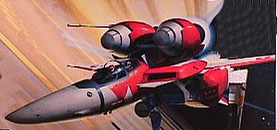 As combat
causalities began to mount on board the SDF-1, it became obvious that the RDF would run
out of trained pilots before combat ready VF-1's. The obvious solution was to draft
and train some of the 70,000 onboard civilians and use them to fly newly repaired and/or
constructed mecha.
As combat
causalities began to mount on board the SDF-1, it became obvious that the RDF would run
out of trained pilots before combat ready VF-1's. The obvious solution was to draft
and train some of the 70,000 onboard civilians and use them to fly newly repaired and/or
constructed mecha.
Due to the expense of high-tech weaponry, and the VF series veritechs versatility, the
RDF decided that it would be best for new pilot's to train in the VT-1 Superostrich.
The VT-1 used the same basic airframe and engines as the traditional VF-1 series of
Valkyrie fighters. However, because of its trainer status, the Mauser RoV-20 head
and nose lasers were replaced in favor of a T-1000 sensor suite. The Superostrich
would use simulated weaponry, to conserve ammunition, and possessed an additional cockpit
for an experienced pilot to fly along and tutor new pilots.
The VT-1 proved to be an excellent trainer. Many of the elite RDF pilots received
there first flights in transformable fighters at the controls of a Superostrich. In
several cases, the VT-1 did enter combat, although this was not because of its combat
abilities. The addition of a second cockpit made the Superostrich an ideal mecha to
use in hostage retrievals were more conventional pickups would prove to be too dangerous.
RPG STATS
- Vehicle Type: VT-1 Superostrich
- Class: Variable Trainer
Manufacturer: Robotech Defense Forces
Crew: Two (One inexperienced pilot, and one experienced pilot)
MDC BY LOCATION:
| Location |
VT-1 |
| (1) Head |
75 |
| Hands (2) |
30 |
| Arms (2) |
75 |
| Legs/Engine Thrusters |
150 |
| (2) Main Body |
250 |
| Reinforced Pilots Compartment |
200 |
| Retractable Utility Arms |
3 |
| Wings (2) |
75 |
| Tails (2) |
50 |
| GU-11 |
100 |
| Arm Conformal Packs (2) |
25 |
| Leg Conformal Packs (2) |
50 |
| NR-NP-E3 Rear Thrusters (2) |
150 |
NOTES:
- Destroying the sensor head of the VT-1 will knock out the mecha's major sensor systems,
including all of the optics systems (infrared, nightvision, thermal). Radar and
communications will be unaffected.
- Depleting the MDC of the main body will destroy the mecha.
SPEEDS:
- RUNNING, SOLDIER CONFIGURATION:
- 160 kph
- LEAPING, SOLDIER CONFIGURATION:
- 50 ft (15 m) high or 70 ft (21 m) long without thrusters.
- FLYING, SOLDIER CONFIGURATION:
- 194 kph
- FLYING, GERWALK/SOLDIER CONFIGURATION:
- Mach One (670 mph/1072 kmph) maximum speed limit in an Earth-like atmosphere. Can also
hover in place indefinitely.
- FLYING, FIGHTER CONFIGURATION:
- Max level speed at sea level : Mach 1.0
Max level speed at 10km: Mach 3.87
- Stall speed : 182 kph (VTOL rectification possible)
Initial climb rate : over 35000m per minute
MAX ENGINE THRUST:
- Two Nakajima/P&W/Rolls-Royce FF-2001 fusion turbines, total engine
output 226kN total at max. power; 451 kN are available with overboost. Exhaust nozzles
allow for vector thrust, serving in place of conventional elevators. System includes two
reverse-vernier thrusters, on blisters outboard of each intake; exhaust comes directly
from main turbine at a maximum of 20% thrust.
- TWO P&W EF-2001 BOOSTER ENGINES: Two chemical egines are
mounted in the FAST pack. Each engine has a total propellant capacity of 11,000 kg
of fuel and can produce 2354 kN of thrust.
- Four Nakajima NBS-1 high-thrust vernier thrusters, one on the ventral
in fighter mode, three in the 'backpack' in
Guardian and Battloid modes.
- 18 x p&w LHP-04 LOW THRUST VERNIER THRUSTERS: These thusters
are distributed around the aircraft, three on each engine block/leg, two on each arm, two
on the nose cone, two on the 'backpack', and four on the torso/fuselage.
STATISTICAL DATA:
- HEIGHT:
- 16.7m in soldier configuration.
- 11.7m in gerwalk configuration.
- 6.3m in fighter configuration.
- WIDTH:
- 9.1m at shoulders in soldier and gerwalk configuration.
- 14.8m with wings at maximum extension.
- LENGTH:
- 5.0m in soldier configuration.
- 11.3m in gerwalk configuration.
- 14.0m in fighter configuration.
- WEIGHT:
- 22,500 kg empty.
- PHYSICAL STRENGTH:
- Equal to a P.S. of 60
- CARGO:
- Small compartment behind pilot's seat for personal belongings in addition to the cyclone
storage compartment
- POWER PLANT:
- Two Tirolian mecha protoculture-generators RT/PS-4d providing a total of 650 MW
- Delta V:
- 200 kps
- COMPATIBLE FAST PACKS
(Macross Mecha Designs):
- Dorsal: NP-BP-01, NP-BP-02, NR-BP-T1, NP-BP-10, NP-BP-11, NP-BP-12, NP-BP-19
Arm: NP-AR-01, NP-AU-T1
Leg: NP-FB-01, NP-FB-T1, NP-FB-10
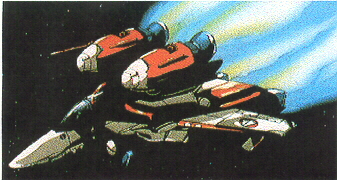
WEAPON SYSTEMS:
- HUGHES GU-11 55mm THREE BARRELED GUN POD: the GU-11 has a
500 round capacity. The cannon fires rounds at 600 rounds per minute and can fire in
all modes. This weapon was normally only issued to the VT-1 with pratice rounds;
however, under combat situations standard armor piercing or high explosive rounds could be
loaded.
- PRIMARY PURPOSE: Assault
- SECONDARY PURPOSE: Anti-Mecha
- RANGE: 1200
- DAMAGE: 3d6 for each short bursts, 6d6 for each medium, or 1d6*10 for a full
melee bursts
- RATE OF FIRE: Bursts equal to the combined attacks of the pilot.
- PAYLOAD: 600 rounds stored internnaly, or 60 short bursts, 30 medium, or 15 full
melee bursts. Ammunition is mounted internally and must be reloaded at any RDF/REF
base.
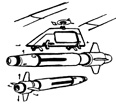
- BODY/WING HARD POINTS: Two fixed hard points are mounted on each wing.
These hardpoints can be used to carry 15 short range missiles, 5 medium range missles or 2
long range missiles.
- HAND TO HAND COMBAT: If necessary, the VT-1 can engage in melee combat rather
than use a weapon. The VT-1 is extremely agile and can execute most typical hand to
hand combat moves, such as punches, jump kicks, leap attacks, rolling with impacts, etc.
DAMAGE:
- Punch in Battloid: 3D6*3
- Punch in Guardian: 3D4*3
- Kick: 3D6*3
- Leap Kick: 6D6*3
- Body Flip/Throw: 3D6*3
- Body Block/Tackle: 3D6*3
- Stomp: 6D6*3 . (only effective against small objects)
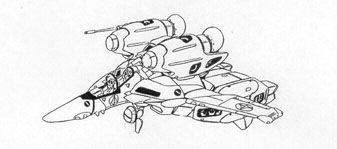
STANDARD EQUIPMENT FOR THE VT-1:
- AUTO-PILOT: The Superostrich is equipped with a computerized auto-pilot,
allowing the pilot to relax or even sleep during long voyages. The auto- pilot can be
programmed with a single destination or a complex flight plan involving multiple speeds,
directions, and destinations. The onboard computer will alert the pilot when the fighter
is near its destination, and can also be set to automatically signal when sensors detect
objects near the mecha. The auto-pilot was designed with long intra-system space journeys
in mind.
- TI-1000 COMBAT COMPUTER: The combat computer tracks and identifies specific enemy
targets, and has a database of over 1,000 images stored in memory. The computer can
identify and track up to 50 targets simultaneously.
- EXTERNAL AUDIO PICKUP: Range: 300 ft (91.5 m). A sound amplification system that
can pick up normal conversation up to 300 feet away.
- HEAT AND RADIATION SHIELDS: Special shielding prevents the penetration of life
threatening head and radiation. A radiation detection and alarm system are linked with the
shields and will sound an alarm if there is a rupture in the shields and what the levels
of radiation are.
- HOMING SIGNAL: The escape pod of the VT-1 is equipped with a homing
device that enables rescue teams to locate a disabled craft or ejected life pod. The range
of the signal is 400 miles (640 km). Most REF ships and veritecs can locate and track a
homing signal, and the onboard computers will automatically notify their pilots if such a
signal is detected.
- LASER TARGETING SYSTEM: Range: 100 miles (160 km). Used for increased accuracy in
the striking of enemy targets and is partly responsible for the mecha's strike bonus.
- LOUDSPEAKER: A loudspeaker system is built into the craft, which can be used to
amplify the pilot's voice up to 90 decibels.
- OPTICS: INFRARED: Range: 2000 feet (610 m). This optical system projects a beam
of infrared light that is invisible to the normal eye, but detectable by the mecha's
sensors. The system allows the pilot to detect hidden/concealed objects by their IR
reflectiveness. The beam will be visible to anyone with IR sensitive optics, however.
- OPTICS: NIGHTVISION: Range: 2000 feet (610 m). A passive light image intensifier
that emits no light of its own, but relies on ambient light which is electronically
amplified to produce a visible picture.
- OPTICS: THERMAL IMAGER: Range: 2000 feet (610 m). A passive optical heat sensor
that detects infrared radiation projected by warm objects and converts that data into a
false-color visible image. The system enables the pilot to see in the dark, in shadows,
and through smoke, and also adds a +10% bonus to pilots using a tracking skill.
- HUGHES AWG-20 X-BAND PULSE DOPPLER RADAR: 200 mile range.
- RADIO/VIDEO COMMUNICATION: Long range, directional communications system with
satellite relay capabilities. Range: 600 miles (960 km) or can be boosted indefinitely via
satellite relay.
- SELF-DESTRUCT: To prevent capture of an advance variable fighter by the enemy,
the pilot can activate the VT-1 self-destruct system, which will cause the fighter to
explode after a delay of up to 60 minutes (time is set by the pilot). The explosive damage
is contained within a 20 foot (6 m) area and inflicts 1D6x10 M.D. to everything within the
radius of the explosion. All internal systems are obliterated. The escape pod will be
automatically ejected prior to the explosion unless the pilot overrides the ejection
sequence.
- STANDARD SURVIVAL KIT: All RDF veritecs come equipped with a portable survival
kit. Inside the small reinforced box is a medium-sized flashlight, two hand flares, one
rocket flare, a compass, infrared distancing binoculars, a small mirror, a pocket knife,
dehydrated and concentrated food (can be stretched into a five day supply for one person)
and basic first aid items (aspirin, bandages, disinfectants, etc.)
- TACTICAL LIFE SUPPORT SYSTEM: The VT-1 cockpit is pressurized, and also provides
additional air feeds to the pilot's flight suit that provides him with pressurized
breathing. The RDF flight suit also contains an upper and lower g-suit that promotes blood
circulation even during high-g turns, thus decreasing the possibility of pilot's blacking
out in combat.
- MARCONI SPYEYE BROAD-SPECTRUM RADIATION SENSOR
- Elettronica Radar Warning Receiver (RWR)
- OlDelft Infra-red Warning Receiver (IRWR)
- Westinghouse ALQ-250(V) active sensor jammer
- Chaff and Flare dispensers: 12 chaff and 12 flares are stored in each
lower leg
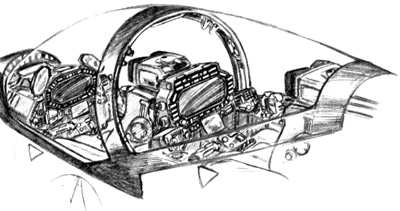
COMBAT BONUSES FOR VT-1 TRAINING:
- 2 attacks per melee (plus those of the pilot).
- Add one additional action/attack at levels six and eleven.
- +1 to strike
- +2 to parry
- +2 to dodge in solder, +4 in guardian, and +6 in jet mode.
- +3 to roll with a punch or fall with an impact, reducing damage by half.
- Critical strike same as pilot's hand-to-hand.
BONUSES FOR VT-1 BASIC TRAINING:
- 1 attacks per melee (plus those of the pilot).
- Add one additional action/attack at levels six and eleven.
- +0 to strike
- +1 to parry
- +1 to dodge in solder, +3 in guardian, and +5 in jet mode.
- +2 to roll with a punch or fall with an impact, reducing damage by half.
- Critical strike same as pilot's hand-to-hand.
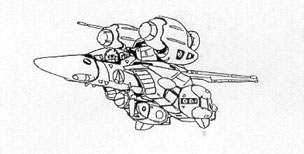
REFERENCES USED IN THIS DESIGN
- Robotech Technical Files: Veritech Valkyrie
- Palladium Books: "Robotech The Roll Playing Game"
- Bandai's B-Club: Issue #73
Back to Mecha Home
 As combat
causalities began to mount on board the SDF-1, it became obvious that the RDF would run
out of trained pilots before combat ready VF-1's. The obvious solution was to draft
and train some of the 70,000 onboard civilians and use them to fly newly repaired and/or
constructed mecha.
As combat
causalities began to mount on board the SDF-1, it became obvious that the RDF would run
out of trained pilots before combat ready VF-1's. The obvious solution was to draft
and train some of the 70,000 onboard civilians and use them to fly newly repaired and/or
constructed mecha. 



